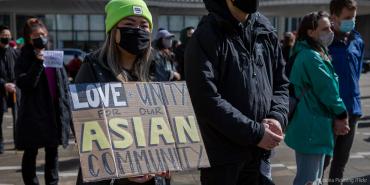Anti-Asian racism is often invisible in our schools and workplaces, but at a workshop during the AFT’s TEACH conference on July 8, a group of educators and union leaders brought it to light with historical accounts and personal experiences, then listed promising solutions to help educators support their own communities and ease this scourge on the nation.
People are surprised when Jessica Tang tells them she was called “chink” in high school, and that strangers have yelled at her in the street, “Go back to China.” As president of the Boston Teachers Union (BTU), chair of the AFT Asian American and Pacific Islander Task Force and an AFT vice president, Tang wants to raise awareness. She has helped establish school programs that teach about Asian American history and culture.
A history of wrongs
Discrimination in the Asian American and Pacific Islander (AAPI) community is nothing new. Tang and other panelists described the Chinese Exclusion Act of 1882, the only law to prevent one particular nationality from entering the country. They recounted a time when Asian American men were not allowed to marry white women, and Asian immigrants congregated in Chinatowns for safety only to be targeted by police violence. Asian Americans were forced into segregated schools and prevented from becoming U.S. citizens. Even labor history was unfair to Asian Americans, with Samuel Gompers championing the movement for exclusion.
Arlene Inouye, secretary of United Teachers Los Angeles (UTLA) and a third-generation Japanese American, recalled the internment camps where her grandparents and her mother (then 20 years old) were sent during World War II. Once the owners of a prosperous farm that produced one-third of the potato crop in California, the family lost everything. Inouye’s aunt died of tuberculosis in the camps and her grandmother became mentally ill as a result of the experience.
The discrimination does not all live in the past. Alvina Yeh, executive director of the Asian Pacific American Labor Alliance (APALA), recalled when hate aimed at Asian Americans became headline news this year after the murders of Asian American women at an Atlanta spa. The incident happened “at the intersection of misogyny and white supremacy,” said Yeh. It rested on a foundation of racial disparity that left the victims working in an industry with few worker protections. In other words, it did not occur in a vacuum.
In fact, it reminded Yeh of her own experience with unwanted sexual aggression and a fear of violence, which have escalated. Asian women in particular are targeted—some beat up in the streets, others spit upon at work or demoralized when customers refuse service from them and insist on white workers instead. “Last year we had over 3,000 self-reported cases of anti-Asian violence,” she said.
The violence is not only physical. In trying to root out the causes of the attacks, Yeh encountered a litany of societal harms to her community: The struggle for access to safe, well-paying jobs and healthcare—even the ability for families to stay together, avoiding deportation and mass incarceration. “It’s these invisible causes of violence that create an uptick of visible violence,” she said.
Moving toward solutions
A thorough understanding of this history and the present-day reality is essential for moving forward, the panelists agreed. In Boston, Tang has helped the union create cultural competency training for teachers so that they know their students’ history, customs and experiences. Noting that there are many different AAPI ethnic groups, Tang said teachers should learn about their own students. For example, they would not want to touch the head of a Hmong student, and they should understand that some Asian American students are taught to avoid eye contact when the teacher is speaking.
BTU’s Ethnic Studies Now committee advocates for a curriculum that includes AAPI history and experience and recently won a full-time ethnic studies coach for its district. The committee has won grants to write curriculum as well. “We really believe that if we’re going to have intra- and interracial understandings, … it needs to be a part of the curriculum,” said Tang. “We also know that students are much more engaged in school when they see themselves reflected and are learning about each other’s cultures and histories.”
APALA is working with labor partners to craft racial equity language for bargaining contracts, case studies and trainings, and a town hall about how the labor movement can show up for Asian Americans. The APALA convention, Aug. 5-8, will dive further into recognizing the legacy of the AAPI community and how, according to Yeh, we can “reimagine a new world that’s beyond borders and across oceans.”
At UTLA, the Asian American Education Project provides training for teachers as well as curricular resources and standards, said Inouye. The union is also part of a steering committee of 20 local organizations working to address anti-Asian hate with districtwide protocols.
Referencing Heather McGhee’s book The Sum of Us, Inouye said, “It’s really important that we embrace the fact that we all lose when any of our groups … experience oppression, racism and hate. And we all win when we address that together.”
[Virginia Myers]

